For nearly 20 years now, I have been fortunate to assist my great musician friend, Dr Joseph Nolan make recordings or concerts on some of the most famous and highly regarded instruments across France and beyond.
I have learnt so much by watching a true expert perform and of course been able to sneak onto instruments that in any other circumstances would have been off limits to a musician of my modest skills.
A long awaited return
There has been a huge gap in this periodic blog series brought about by the pandemic. Our original plan was all set to meet again at La Madeleine in Paris in early 2020 for the marathon challenge of recording the complete organ works of Charles-Valentin Alkan (1813-1888).
La Madeleine was the preferred venue as Alkan had played that instrument.
After pandemic travel restrictions diminished, the Madeleine organ was unavailable. It was subject to some repair work and then the church also had building work in progress, so it became impossible to fix a date with the authorities there. The search began for a suitable alternative venue that would do this amazing repertoire justice.
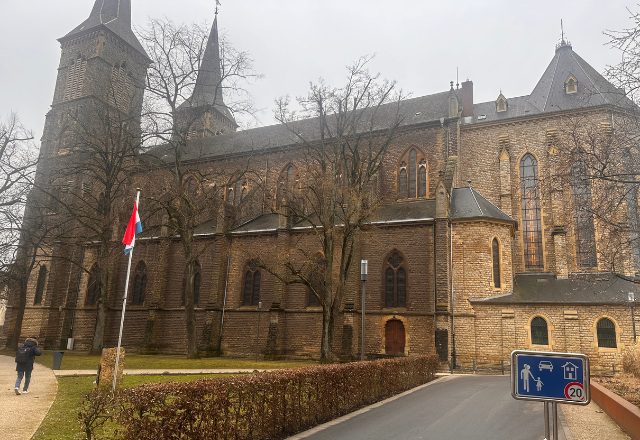
Finding the perfect venue
Eventually, we were incredibly fortunate to be hosted by the Eglise St Martin that boasts a truly huge 4 manual instrument with about a 6 second acoustic and the – all but essential – stepper system to manage the multitude of rapid stop changes that many of the Alkan pieces require. The church is rightly proud of its instrument and the hospitality and arrangements were exceptionally accommodating. It was a much more relaxing venue than some we have visited and being able to start recording early in the evening also took some of the stress factors away.
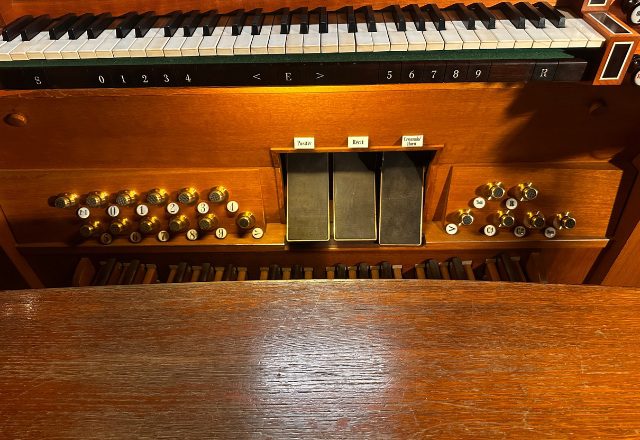
The challenge begins
We departed from Heathrow’s Terminal 3 on a Friday lunchtime in January, arriving in Luxembourg for an evening meeting at the church to be handed keys to both organ and building. The marathon challenge was on – over four hours of music to prepare and register, with the first recording session starting on the Monday evening.
We returned to the church on Saturday to explore the instrument and begin the huge job of setting up registrations, a task we came to find more troublesome than we would have liked as working with only general pistons severely complicates speedy sound navigation. Eventually, we speeded up the process as we became more familiar with the hardware, but it was not without some blunders that added to the anxieties of the task ahead. As I mentioned earlier pandemic and finding a suitable instrument had delayed this recording by four years. Keeping this huge and complex repertoire fresh must have been a significant burden. Certainly there was a massive sense of anticipation of the challenge that lay ahead as we started to set up registrations and sound engineer Tom Lewington worked out the best positions for the microphones.

The iPad experiment – a lesson learned
I had anticipated that this blog would actually be the ‘Diary of a Redundant Page Turner’ as Joseph had prepared all the music on an iPad with automatic page turn that could be triggered by a series of facial gestures. I could not have been more wrong and the experience of the iPad for this session has confirmed that it will never again be used for this type of work.
If you are at all interested, here are the reasons why:
- In subdued lighting situations we just could not get the facial gesture page turn to be reliable. A Bluetooth option would have worked but we did not have one to hand, but then all but one of the following issues will still have persisted.
- Working with the largest iPad the page size was just not big enough to clearly show the extraordinary mass of notes with sufficient clarity.
- When in ‘edit mode’ adding piston markings the iPad page turn is locked out and it was all too easy to forget to come out of edit mode. So, there you are back recording and hit the page corner to trigger the turn and nothing happens!
- The ‘touch’ facility to turn a page was so sensitive that too many times I found I turned two pages with calamitous consequences.
- At times I also managed to trigger not just a page turn but a total advance to the next piece.
- And finally, as the iPad only shows a page at a time, there are double the number of page turns to complete!
This no doubt demonstrates a lack of familiarity with all the features and perhaps with practice the issues described above would melt away but we both regretted that the paper scores had been left behind in Australia and the iPad undoubtedly made the job harder than it need have been.
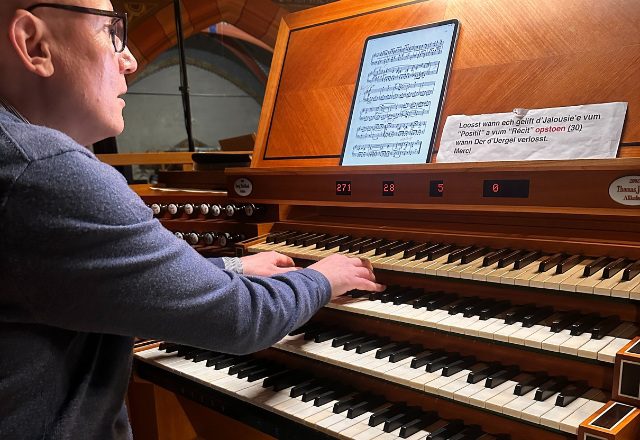
A deeper look into Alkan’s music
Before I get into the detail of the four busy days in Dudelange, I must share with you my delight at being introduced to the music of Alkan. He is absolutely up there with Widor in terms of magnificence albeit in a very idiosyncratic style.
The only reason I can attribute to his lack of profile is that some of the music is just so, so difficult, most musicians would walk away from it rather than bother to try. But there are also many simple and charming short pieces that are well within the range of a grade 8 musician and some even grade 6.
Alkan was a recluse and predominantly a virtuoso pianist. Apparently, he was the only pianist that Liszt feared as a technical rival. Much of what Joseph records was actually written for a pedal clavier. That’s a piano with a pedal board. These works must be adapted for organ as the piano keyboard offers 88 notes while the organ is limited to 61.
And as many organists will know, music written in a pianistic style with liberal use of a sustain pedal is notoriously difficult to pull off on the organ, the Reubke Sonata being perhaps the best known piece that presents this challenge.
Much of the repertoire was written as student studies including 12 pieces for feet alone that present what is undoubtedly the most technically difficult challenge with many circumstances where both feet are required to play two notes each in rapid scale like passages.
In contrast some of the etudes for keyboard alone are almost without technical challenge. It’s hard to understand what inspired this writing as I don’t believe Alkan was writing it for his own students, as he had none. Coming from a wealthy family he had no need to generate regular income.
If there is one piece that sets Alkan in a league of his own, I think most will agree it’s his Impromtu on the Lutheran Chorale Ein Feste Burg. 30 years ago, Kevin Bowyer recorded the complete works over a much more extended period. In his version of the Impromtu on YouTube wait for the fugue entry at 8.05 and hold onto your seat for what is certainly one of the most exciting organ passages you will ever hear. I hope to add a link to Joseph’s recording when it gets published towards the end of 2025.

The challenges of page turning
Working as a page turner can be stressful, especially when being asked to follow frantically speedy sections, it can be hard to know exactly where one is. Often, I hope to find an easy-to-follow pedal line near the page turn. These were sadly not abundant.
My next clear clue was to try and follow where the score line changed from octave passages to single notes. That soon proved to be unreliable as some of the octaves were never played being notes beyond the organ compass.
I soon found that I could not ‘join the page lower down’ but had to follow every bar to be as sure as possible the page turn, iPad permitting, would be in the right place. The page turning challenge could not have been harder but still in contrast to the playing challenge remained a walk in the park.
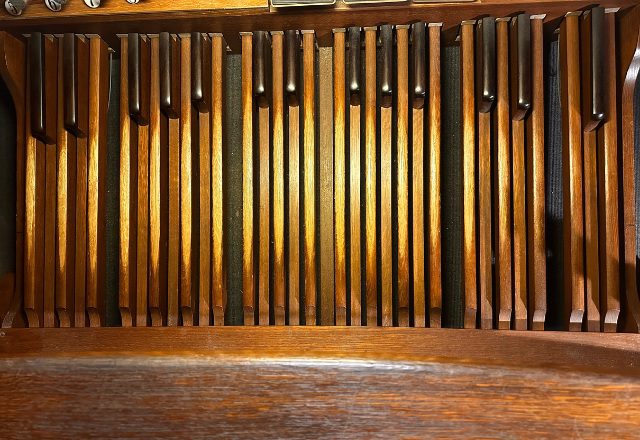
The recording sessions
The recording sessions took place on the evenings of January 20th to 23rd, 2025. The church built in 1903 sitting in the town square has a huge west end gallery instrument.
The recording and editing desks were set up on the far south side of the gallery. Tim Oldham in the producers seat and Tom Lewington managing all the recording equipment. We worked out a plan which was more or less kept to deciding to get some of the most technically demanding pieces out of the way first.
Anything could be played up to 11.00pm but after that we were expected not to play at loud volume levels. An unexpected navigational issue soon emerged. The church clock directly above us struck all the quarters and at 7.00pm and 10.00pm the hours had extended peals. I found added to my duties was observation of our proximity to ‘the bells’ at times delaying recording starts to ensure a retake would not be triggered by unwanted background noise.
The instrument combines some of the characteristics of French Romantic instruments with more classical German voicing. As such it was able to get close to the soundscape Alkan will have had in his head when he wrote the works. The scores offer no registration suggestions at all. It’s all left to the performer to decide how best to match the instrument with the score. You will find a detailed account of The Stahlhuth / Jann organ further down this linked page.
Happily, despite our town centre location we very rarely had to retake due to passing police or ambulances. Only on one occasion did we feel the need to go past 11.00pm to try to head off the following days’ time pressure. Indeed, the church was booked for 5 complete nights and Joseph finished a day early making only 307 takes to capture the complete works.
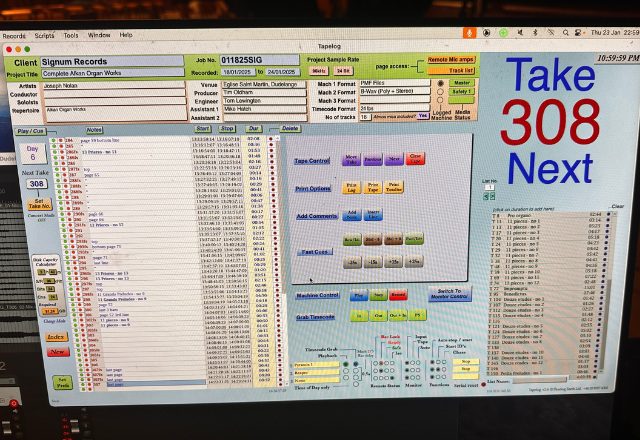
Battling a cold and wrapping up
By the Thursday night I had caught a severe cold and was struggling to avoid coughing. At the end of every take, one stays quiet until the church returns to silence, which I was now finding a new and unwelcome struggle. By about 10.30 pm the job was complete. The epic sessions were over and any thought of slipping off to a bar for a celebration was soon overtaken by the need to get to bed.
Friday became a very welcome ‘day off’ Joseph went to the airport for his early Saturday flight and apart from a brief lunch out we spent all day in our hotel room recovering from the onslaught.
Saturday saw Joseph take a flight to Munich to catch a flight back to Perth Australia and I returned to Heathrow. Just a day off before returning to the office to catch up on two weeks admin and life back to a less stressed normal.
What’s next?
Is this the final ‘Diary of a Page Turner’ entry I will write? Who knows. Plans are afoot for another European venture in early 2026, but we will have to wait and see what finally comes together.

I have had a passion for church organs since the tender age of 12. I own and run Viscount Organs with a close attention to the detail that musicians appreciate; and a clear understanding of the benefits of digital technology and keeping to the traditional and emotional elements of organ playing.
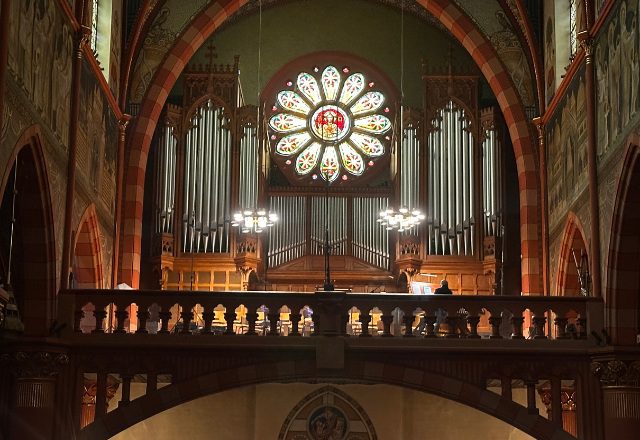



I was just scrolling through this article when my eyes fell on the ‚Stahlhut Aachen‘ nameplate. When I was EE student in Aachen in the late 70ties I worked there and went on organ restauration tours with them. Great life experience.